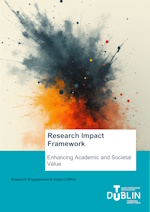Introduction to Research Impact:
Welcome to the Research Impact Resources Page for Technological University Dublin. This resource is designed to support our academic community in understanding, achieving, and demonstrating the impact of their research. Here, you will find a collection of tools, guidelines, and best practices to help you navigate the various aspects of research impact, from initial planning and stakeholder engagement to impact assessment and dissemination. Our aim is to empower researchers to create meaningful change within academia, industry, and society at large, ensuring that the innovative work conducted at our university reaches its full potential. Explore our resources to enhance the visibility, reach, and real-world application of your research endeavours.
Unlock the full potential of your research with our Research Impact Framework, designed to help you strategically plan for, track, and showcase the meaningful outcomes of your projects. It can help you from the planning stage in grant applications and research projects, to monitoring progress, and finally effectively communicating outcomes at pivotal moments. Access the full framework by clicking the thumbnail image below and/or watch the video introduction.
If you have any queries just email us:
- Research Engagement & Impact Office: engagementandimpact@tudublin.ie
- Research Impact Lead: gordon.cooke@tudublin.ie
- Book a chat with me
- Come along online to the weekly drop-in clinic 2-3pm every Friday till December 14th 2024 (inclusive)
1. Understanding Research Impact
Funders are increasingly required to give evidence of value for money for the taxpayer. The demonstration of tangible benefits to society and the economy are now frequently required from funded research undertaken in Universities.
- RESEARCH IMPACT CAN BE DEFINED AS...
…the contribution that research makes to society, the environment, the economy, industry, culture, public policy and services, health and quality of life, and collaborations to achieve these.
 Figure 1: This figure presents a comprehensive overview of research impact examples across the five faculties within the university: Science & Health, Computing, Digital and Data, Business, Arts & Humanities, and Engineering & Built Environment. Each faculty is depicted with specific examples of research impact categorised into three scales: small scale, medium scale, and large scale. DOWNLOAD HERE.
Figure 1: This figure presents a comprehensive overview of research impact examples across the five faculties within the university: Science & Health, Computing, Digital and Data, Business, Arts & Humanities, and Engineering & Built Environment. Each faculty is depicted with specific examples of research impact categorised into three scales: small scale, medium scale, and large scale. DOWNLOAD HERE.
- Small Scale: Involves localised and specific initiatives such as innovations in lab techniques, development of internal software, and enhancements in teaching methods.
- Medium Scale: Covers regional and community-based projects, including public health programs, digital infrastructure projects, and regional economic development initiatives.
- Large Scale: Encompasses national and global impacts, such as contributions to international health guidelines, digital policy reforms, and influence on global economic trends.
This structured layout demonstrates the diverse and multi-faceted nature of research impact across different academic disciplines, highlighting the varying levels of influence from local projects to international collaborations.
------------------------------------------------------
2. Impact Planning for Grants
Impact is easier to find and evidence if it is planned, monitored, and communicated. Every research project should have an Impact Pathway Plan. The Kellogg Foundation Basic Logic Model is a systematic framework used to plan, implement, and evaluate projects or programs to achieve desired outcomes and impacts. It consists of the following key components:
-
Inputs: These are the resources, such as time, money, personnel, and materials, that are invested in the program or project. Inputs are essential for the implementation of activities.
-
Activities: These are the actions, processes, experiments, or interventions undertaken using the inputs. Activities are designed to produce specific outputs and outcomes.
-
Outputs: These are the direct results of the activities, often measured in terms of quantity. Outputs are tangible products or services delivered by the program, such as peer reviewed papers published, workshops held, materials produced, or people served.
-
Outcomes: These are the specific changes or benefits that occur as a result of the activities and outputs. Outcomes are typically categorised as short-term, medium-term, or long-term, reflecting the progression from immediate effects to broader, sustained impacts.
-
Impact: This represents the ultimate, long-term change or benefit that the program aims to achieve. Impact is often broader and more far-reaching, affecting individuals, communities, or systems at a fundamental level.
By clearly defining and linking these components, the Kellogg Foundation Basic Logic Model helps researchers plan strategically, monitor progress, and evaluate the effectiveness of their efforts in achieving meaningful and lasting impact.
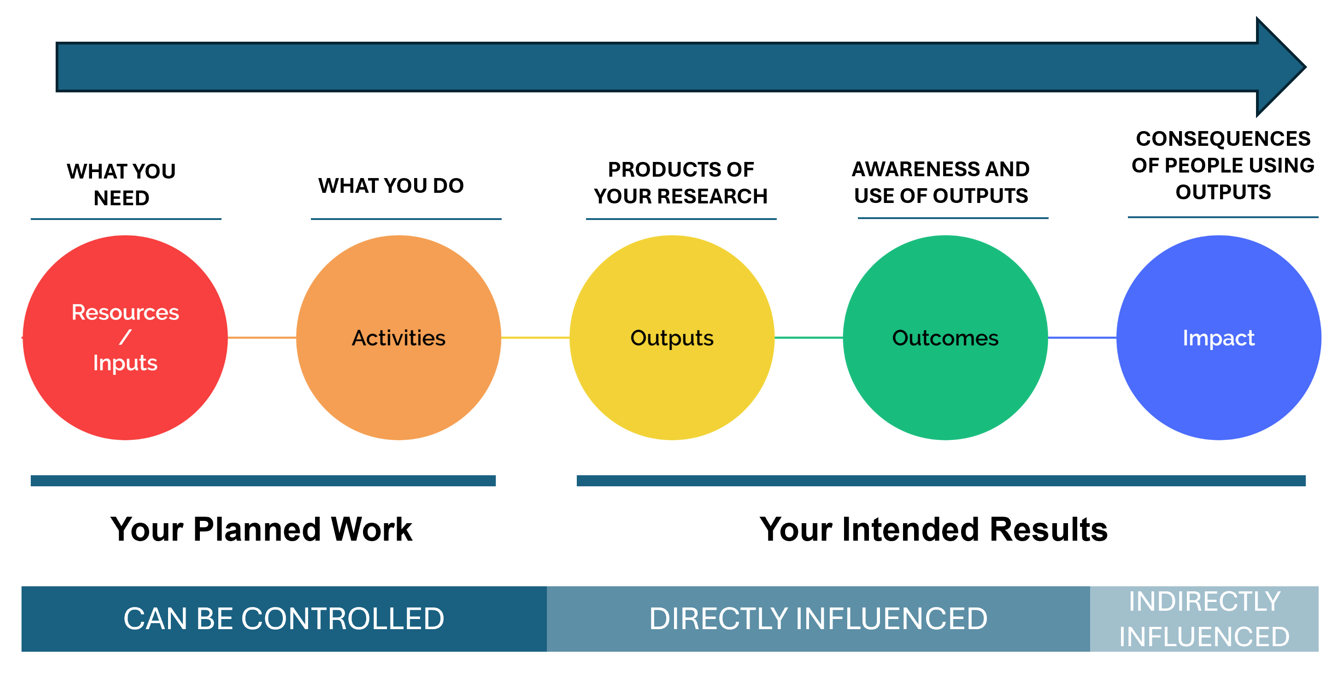
Figure 2: This diagram illustrates the Kellogg Foundation Basic Logic Model, which outlines a structured approach to achieving research impact through planned work and intended results. The model is divided into five interconnected components. The model also highlights the level of control and influence over each component: DOWNLOAD HERE.
- Your Planned Work (Inputs and Activities) can be controlled by the researcher
- Your Intended Results (Outputs, Outcomes, and Impact) are influenced by the researcher but to varying degrees, from direct influence (outputs and outcomes) to indirect influence (impact).
------------------------------------------------------
3. Resources and Tools
The "Guide to the Researcher Impact Framework" by the Irish Universities Association, published in October 2022, provides a comprehensive framework for researchers to plan, assess, and demonstrate the impact of their work across various domains. This guide aims to enhance the visibility and societal relevance of academic research in Ireland.
The "Impact Webinar" PDF by Science Foundation Ireland offers a detailed presentation on how to measure and communicate the impact of research projects. It covers key concepts, methodologies, and practical examples to help researchers effectively demonstrate the societal and economic benefits of their work.
The "IUA Engaged Research Planning for Impact Framework" 2022 update provides a structured approach for researchers to plan and achieve impactful engagement with stakeholders. This guide aims to enhance the societal and academic contributions of research through strategic planning and effective communication of outcomes.
"Impact 2030: Ireland’s Research and Innovation Strategy" focuses on maximising the impact of research and innovation on the country's economic, social, and environmental challenges. The strategy is structured around five pillars, including enhancing talent, supporting enterprise success, and fostering global connectivity, with a comprehensive implementation framework to guide progress.
The "Kellogg Foundation Logic Model Guide" provides a comprehensive framework for planning, implementing, and evaluating programs to achieve desired outcomes and impacts. It details the components of the logic model, including inputs, activities, outputs, outcomes, and impact, offering practical guidance for developing and using logic models effectively.
The "Planning for Impact" template is adapted from the W.K. Kellogg Foundation Logic Model Development Guide and is designed to help researchers outline their planned work and intended results. It includes sections for detailing resources/inputs, activities, outputs, outcomes, and impacts, facilitating a structured approach to achieving and measuring research impact.
The "Template for Research Impact Case Study" is a structured document designed to help researchers systematically document and present the impact of their work. It includes sections for background, objectives, methods, outcomes, and evidence of impact, providing a comprehensive framework for creating detailed and informative impact case studies.
The UN's official list of Sustainable Development Goal (SDG) indicators provides a comprehensive framework for measuring progress towards the 2030 Agenda for Sustainable Development. It includes 231 unique indicators used globally to track and report on various aspects of sustainable development, ensuring consistent monitoring and evaluation across countries. This allows you to more closely link your research outcomes and impacts to the UNSDGs.
1. Pathways to Impact
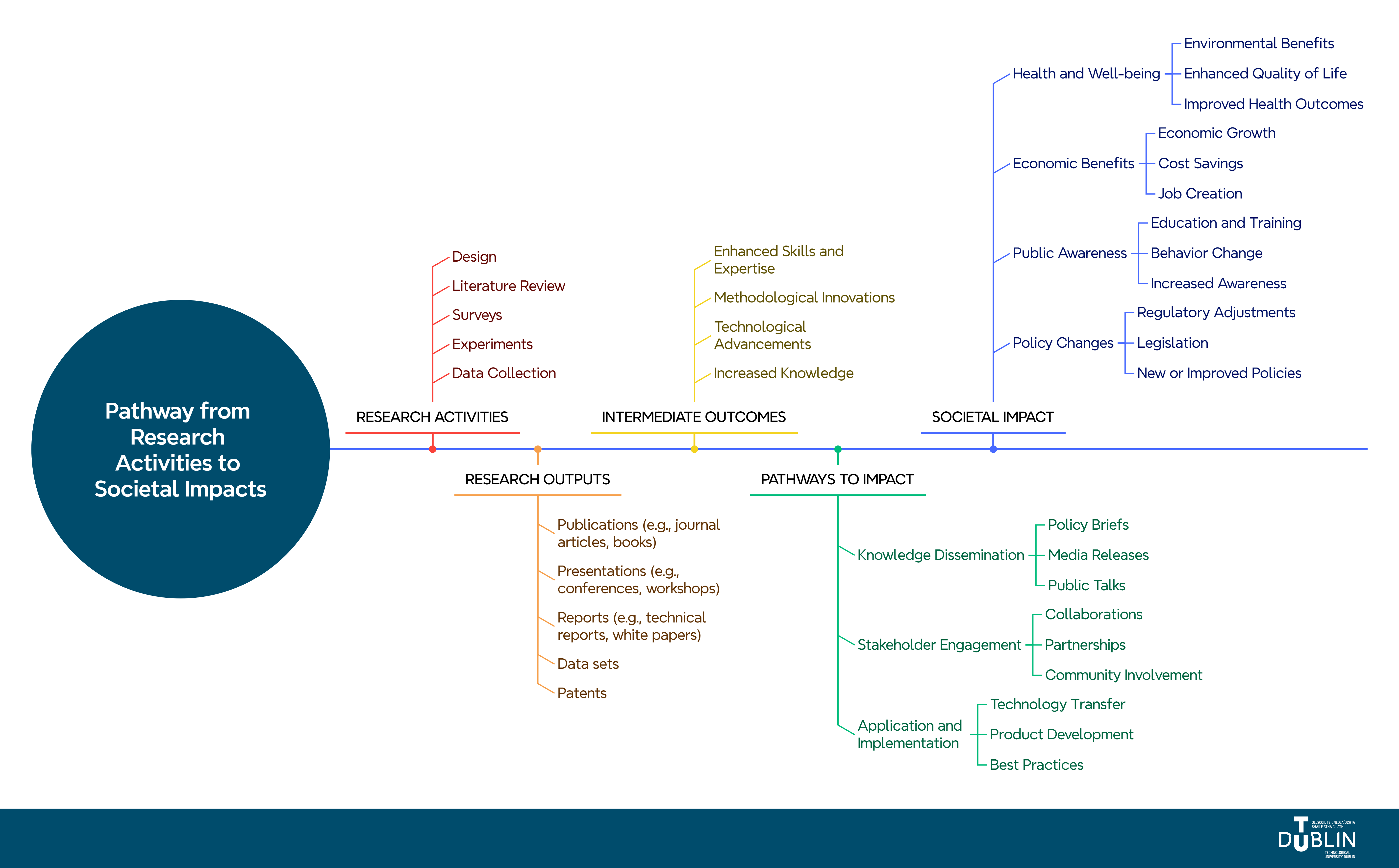
Figure 3: This diagram illustrates the progression from research activities to societal impacts. Starting with research activities such as design, literature review, surveys, experiments, and data collection, it moves through research outputs, including publications, presentations, reports, data sets, and patents. These outputs lead to intermediate outcomes like enhanced skills, methodological innovations, and increased knowledge. Pathways to impact, including knowledge dissemination, stakeholder engagement, and application, result in various societal impacts such as health and well-being improvements, economic benefits, public awareness, and policy changes. DOWNLOAD HERE.
------------------------------------------------------
2. Example Timelines for Achieving Societal Impact
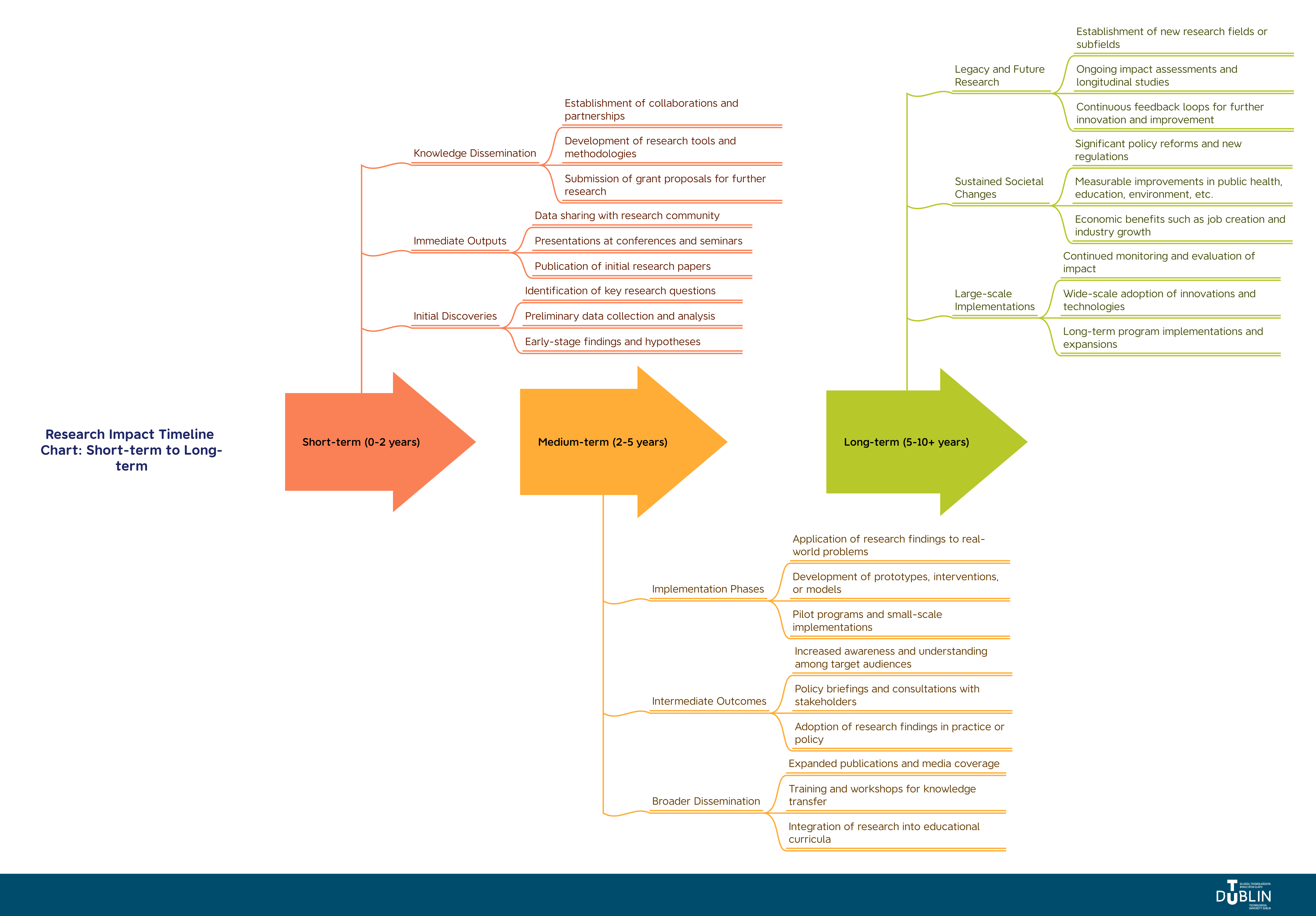
Figure 4: This chart delineates the progression of research impact over different timeframes: short-term (0-2 years), medium-term (2-5 years), and long-term (5-10+ years). DOWNLOAD HERE.
- Short-term: Initial discoveries, knowledge dissemination, and immediate outputs such as preliminary findings, presentations, and early-stage collaborations.
- Medium-term: Intermediate outcomes and broader dissemination, including the implementation of pilot programs, increased stakeholder engagement, and adoption of research findings in practice and policy.
- Long-term: Sustained societal changes and legacy research, characterised by large-scale implementations, continuous innovation, and significant economic, health, and policy impacts.
------------------------------------------------------
3. Scale and Reach of Research Impact
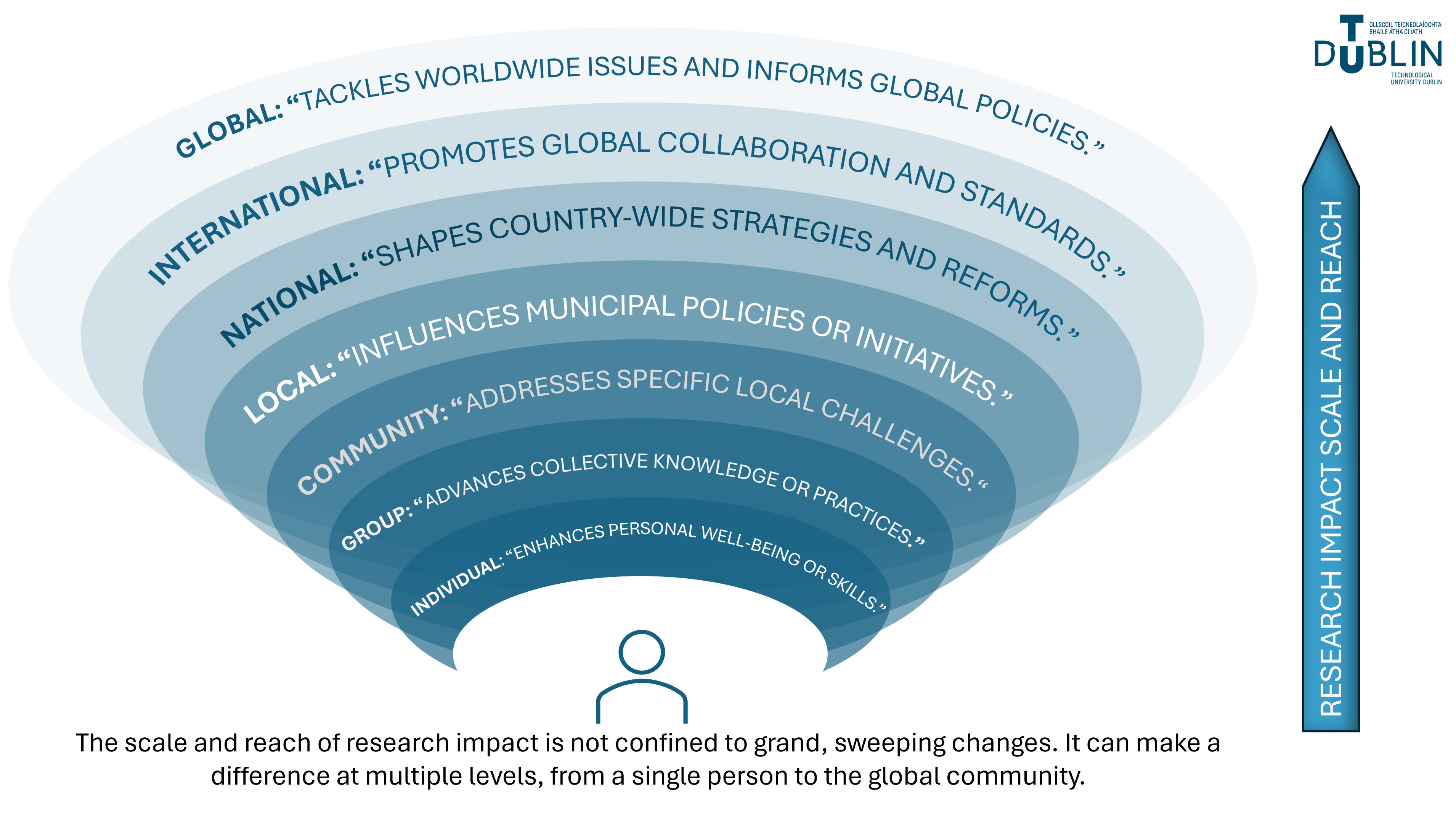
Figure 5: This diagram illustrates the varying scales and reach of research impact, ranging from individual to global levels. At the individual level, research enhances personal well-being or skills. Group-level impact advances collective knowledge or practices. Community-level addresses specific local challenges, while local-level influences municipal policies or initiatives. At the national level, research shapes country-wide strategies and reforms. International-level impact promotes global collaboration and standards, and global-level tackles worldwide issues and informs global policies. The scale and reach of research impact highlight its potential to affect change at multiple levels, from personal to global. DOWNLOAD HERE.
A significant portion of research outputs remain unknown and unutilised. Studies indicate that many research findings do not translate into practical applications or products, and only a small percentage of research achieves significant impact. This can be due to various factors, including the lengthy process of translating research into marketable products and the challenges of effectively communicating research findicngs to a broader audience. Below are some ways you can better communicate your research so that it has societal impact.
1. Writing Impact Case Studies
- Impact case studies provide detailed examples of how research has led to significant changes in policy, practice, or society. They illustrate the pathways from research activities to real-world outcomes, showcasing specific instances where research has made a tangible difference. View our latest research impact case studies here.
- Click here to download the Impact case Study Template
------------------------------------------------------
2. Writing Policy Briefs
- Policy briefs are concise documents that summarise research findings and offer recommendations for policymakers. They are designed to inform and influence decision-making, ensuring that research insights are translated into practical policies that benefit society. If your research has the capacity to inform policy makers then you should consider publishing a policy brief. We're currently working on getting a procedure approved and will publish more information very soon.
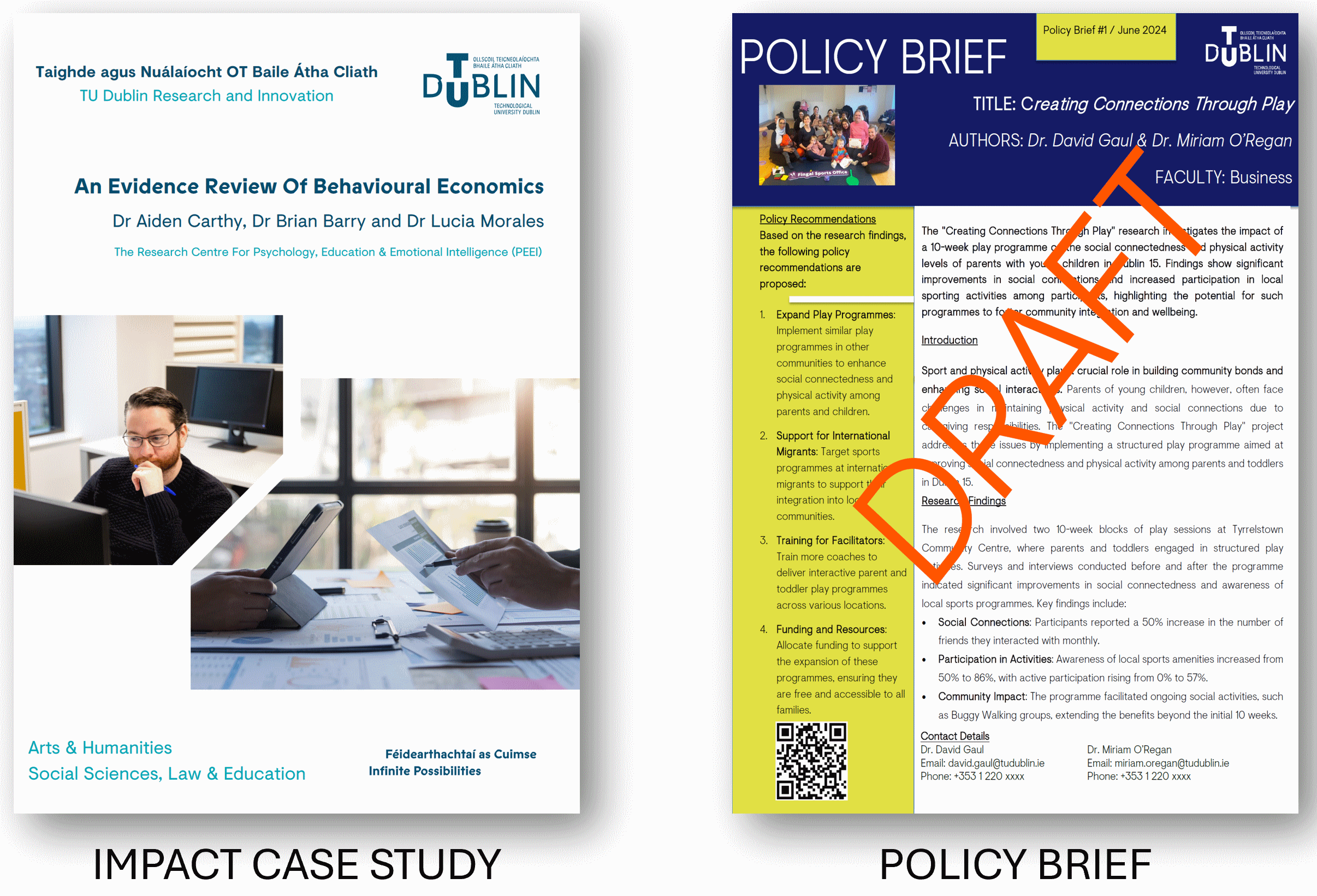
Figure 6: This image illustrates two formats for communicating research impact: an Impact Case Study and a Policy Brief. The Policy Brief procedure will be published soon.
------------------------------------------------------
3. News and Social Media
- We encourage researchers to share their success stories on the R&I News site to effectively promote and elevate the communication of their groundbreaking outputs and significant impacts, showcasing their valuable contributions to a wider audience. If you have a positive news story from your research and innovation projects or require marketing and communication support for an event to showcase your research findings, please complete the form available at: https://forms.office.com/e/MsExbcdrEP. Additionally, you can email any supplementary information to researchandinnovation@tudublin.ie.
- It's also worth sharing research results, outputs, and outcomes via your own social media platforms—whether through project-specific channels or personal accounts—to effectively promote and elevate the communication of your impactful work to a broader audience. You may tag relevant TU Dublin social media accounts so we can amplify your message.
------------------------------------------------------
4. Using Visuals and Infographics
- Researchers should, were appropriate, consider utilising visuals and infographics to enhance and elevate the communication of their outputs. Making complex information more accessible and engaging for diverse audiences means your work is better understood. This is a key path towards achieving societal impact. You can design your own infographics using Adobe Express. Here's a mock-up: infographicexample


